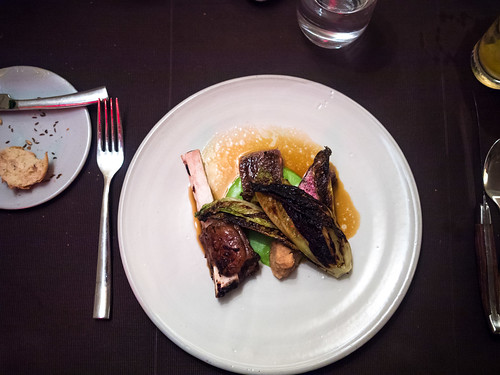Editor's note: Betony has since closed since my meal there. When I ate there they had already decided to close.
The host at Betony sat the woman in the sequin mini dress first. I wasn’t surprised. Just as I wasn’t surprised to see a trio of dudes hanging by the bar throwing back milk punch and cognac. In New York every restaurant house the pre-club crowd. After all, what better way to coat the stomach against the night’s Grey Goose than with a $100 tasting menu?
But for my boyfriend and I, an average pair of twenty-somethings, dinner at the late Betony was a bargain. It was cheaper than a trip to the theatre or a night at the club and more entertaining than either.
Le Coucou, Günter Seegar, Augustine: meet New York’s new generation of restaurants eager to tutor eaters reared on chef-approved noodle joints on the finer points of high cuisine. From table settings to artful platings, there are plenty of metrics for judging these restaurants. And young diners like us are ready to learn. Restaurant critics might complain, but most diners will agree that plopping down upwards of $100 for a meal earns you the right to critique.
We didn’t love the wood paneling. We debated the table décor in comparison. We discussed whether to follow Pete Well’s recommendation to order the chicken or follow our stomach and order the skate. After all, when you consume more chicken in Chop’t salads than you do chicken from Michelin-starred kitchens, you need to train your palate. Forget paying for entertainment, we paid for education.
Betony offers both a set and a tasting menu, but most diners opt for the set menu. It’s a relative bargain. About $100 gets you an appetizer, entrée, and dessert, plus a smattering of amuse bouche. You can add a wine pairing, but you’d be better off ordering an astonishingly creamy-but-light glass of milk punch or deep and sweet sherry drink. If you insist on wine, choose a bottle or glass from the leather-bound wine list that gives drinking the reverence of an illuminated manuscript.
Betony wants to bridge this gap between past and present, which you realize the moment you climb the steps to the upper story dining room. While downstairs diners snuggle amidst wood paneled walls seemingly stolen from a Vaudeville theatre, upstairs wood panels give way to brick walls from a Williamsburg-themed TV set. If the brick walls are Williamsburg, the tables are Stockholm—large and pale with a sleek lamp in lieu of a candle. Betony wants to remind you that old-school dining remains relevant in the 21st century, even when the symbols shift.
Sometimes you believe and sometimes you wish you swung by the canteen at a living history museum instead. You float aimlessly at the island-like tables—until they’re filled with dishes. You feel fine during your appetizer, awkward until the amuse bouche arrives and filled with just as much shame as food after dessert as you wonder how you ate so much.
That’s because each course is large enough to satisfy on its own. I wish my radish salad hadn’t been soaked in dressing and while I loved my pseudo-fried fish, the combination of crispy roasted mushrooms and rich miso would have been just as satisfying if I’d spent $30 on it as a single course. You become despairing of the amuse bouche, which are the most compelling parts of the meal. The chilled truffle broth dotted with browned butter tastes like dragging your finger through the dregs of the parmesan truffle fries from your go-to gastropub. And who could resist the fresh sorbet that precedes dessert? Bright and pungent, it almost makes you excited about yet another course.
Perhaps that’s the issue with contemporary fine dining—it participates in a dining culture where more means value, shifting the definition of satiation from just enough to too much. While diners at Betony no doubt snuff their noses at Cheesecake Factory portions, the notion that of a bargain alters how we interact with dining. Because we aren’t always fine dining. You’ll swing by Chipotle or the Whole Foods salad bar. Fine dining is an educational experience, it’s a theatrical experience and a gastronomic one. Betony demonstrates the successes and challenges of navigating these different discourses for the 21st century diner.
And I wish I could go back.

